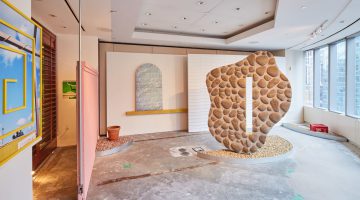Speeding around the Matterhorn, that beautiful fake mountain, in a run-away mining cart, I was thinking of Paul McCarthy. I spent a large part of my trip to Disneyland last month reflecting on my conversation with him about his new sculptures (at both Hauser & Wirths,) as well as anticipating the monumental installation “White Snow,” which just opened in preview at the Armory.
It doesn’t take any special imagination to understand the formal connection between Disneyland dioramas and McCarthy’s animatronics, though, while in the Mouse’s kingdom I began wondering about “emotional narratives and discontinuity,” ideas that returned as I wandered around the vast Drill hall this morning.
There are a few rides at Disneyland that actively disregard narrative, even as they are “rides” through time and space. “Pirates of the Caribbean” and “It’s a Small World” are a phantasmagoria of vivid flashes; they don’t “add up,” (not coincidentally neither emerged from a movie; in the case of “Pirates,” the ride came first). The rest relate directly to Disney’s animated films, the rides are vehicles for re-experiencing the films emotionally. The Peter Pan, Snow White, or Mr. Toad rides, for example, wholly depend on you knowing the narrative beforehand, in fact, knowing it by heart, so that the rapid succession of tableaux—each with only enough time for a single gesture or phrase—to activate emotions already extant. If you had no idea about Disney’s Peter Pan, you might enjoy being jostled around but it would be impossible to suture together the repeating characters or lush spaces into any sort of intelligible or “satisfying” story.
This informs how McCarthy is using Disney’s “Snow White,” turning her into his White Snow—as a character she is readymade emotional architecture dressed as an impossibly beautiful group of images. Children’s stories, of course, predate the child’s own first hand adventures—fairy tales inflect later experiences as they happen, actually. With accumulated living these texts change complexion, deepen and distort.
“White Snow” is a series of 10 video projections of performances which took place in a huge fake forest and house McCarthy created, all installed in the center of the space, complete with huge pastel film lights. The opposite ends of Drill Hall show a multi-channel 7 hour sequence, with small rooms along the side screening individual scenes. All together it is some 28 hours of film, cut down from several hundred.
McCarthy plays “Paul Walt,” an amalgamation of himself and Walt Disney, who is embroiled in various psychosexual scenarios with White Snow: he cries as she asks him about doing his homework; he shoves a boom mic into her mouth; she covers his face with ketchup, etc. There is a very sad sequence where he follows her through the forest at night, howling, crying, falling down. None of this adds up to a “story” other than it allows the development of a certain emotional continuity from image to image, which must be fleshed out with what each visitor brings into the room. It adds up to something, but you have to wander through for hours, and I look forward to doing that. The videos are beautiful even as they are sad or vulgar. It is a monumental work I’ll write more on later.
For more information visit here.
-Contributed by Jarrett Earnest






